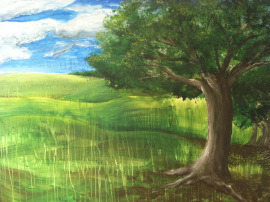|
|
Project Description
Opposites attract. At least that is what some say. When looking at the world, we are engaged by a host of colors, vibrant, subtle, engaging, and disturbing. This project seeks to look at the world around us and reinterpret it to deepen your understanding of color and its purpose in our lives. Essential Questions: Why does color make such a difference? What colors are your favorites? Where in landscapes do you see these colors? Does your choice of landscape depend on your favorite colors? If so, does that effect where you like spending time? Do your preferences in color determine whether you are comfortable or not? Activity 1 Create an inverted color wheel. Draw three concentric circles. Divide each circle into corresponding six parts. Fill in the parts of the outer circle using the following colors in the following order: Red, Orange, Yellow, Green, Blue, Purple blending the colors together where they meet. Now fill in the inner circle in the opposite order so that the colors blend in the opposing order: Purple, Blue, Green, Yellow, Orange, Red. If you complete this properly, the complimentary color will be directly beneath it's corresponding primary. Activity 2 Create inverted tertiary color bars (value scales). You will create six value scales the color combinations are: red to green - green to red, purple to yellow - yellow to purple, blue to orange - orange to blue. The scales should be directly underneath each other so as to see the comparison in color. Activity 3 You will paint/draw a landscape using the true colors of the image. In sketches and composition studies you will determine a "color map" of the image. Color mapping is essentially breaking down the image into color chunks, like a paint by number. After the separation of color zones in the map, you will begin to fill in the colors appropriately according to your new inverted color wheel and scale. Activity 4 You will paint/draw the same landscape as Activity 3 only reverse. Again, you will separate the color zones. after the zones are separate, you may begin to fill them in using the opposing color to the original using your color wheel and scales. note: white becomes black and vice versa, so clouds will be black and holes will be white, etc. |
| inverted_landscape_rubric.docx | |
| File Size: | 160 kb |
| File Type: | docx |




